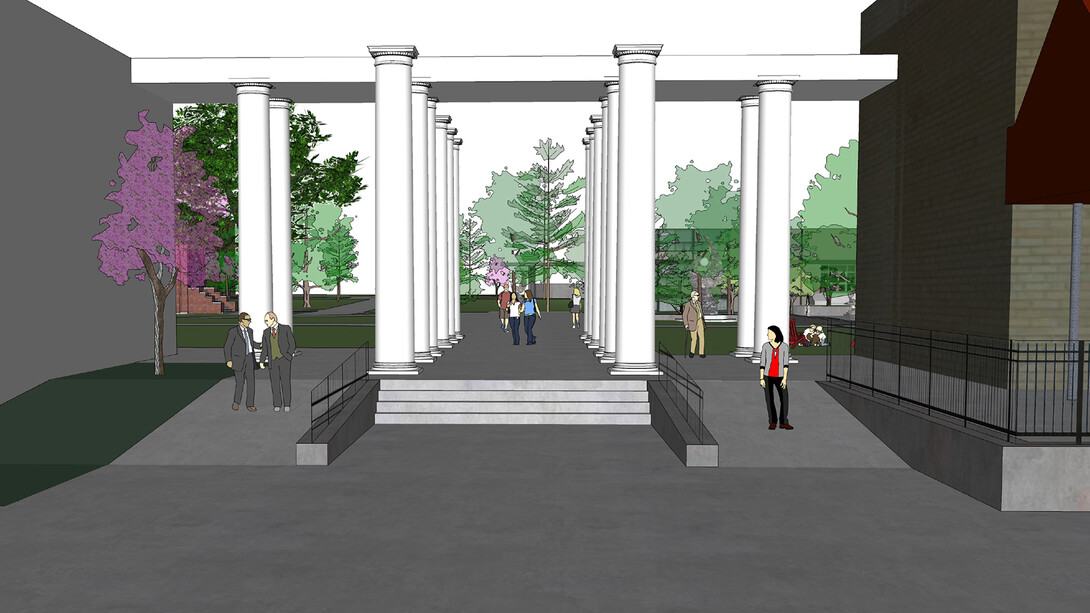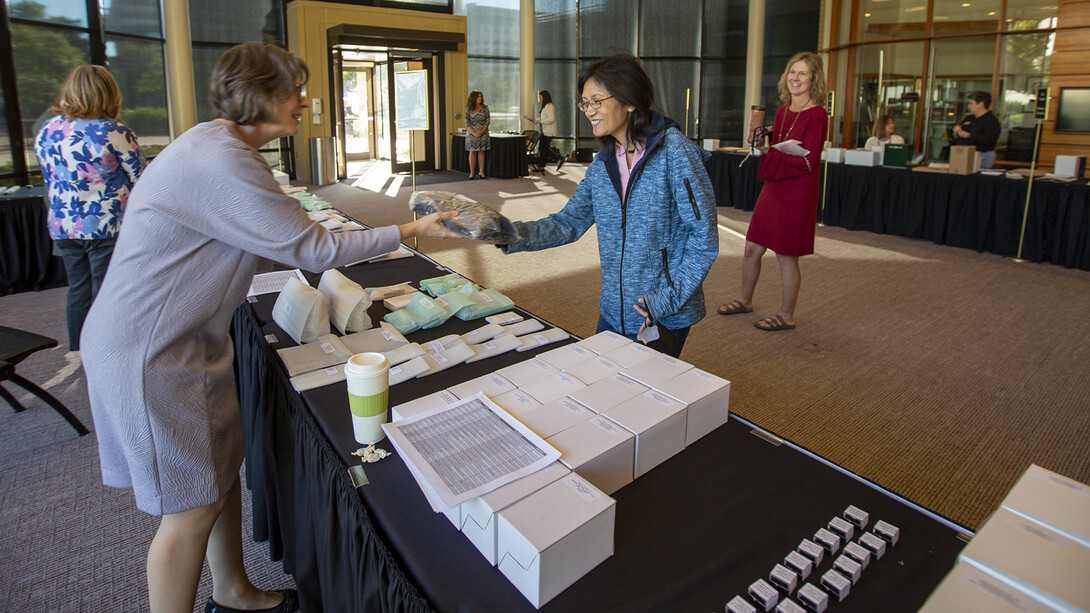
Building upon a celebration of employees and their role in powering the University of Nebraska–Lincoln’s successes, Chancellor Ronnie Green set an enrollment goal and announced the future home of a set of historic columns during his Sept. 28 State of Our University Address.
Held at the Lied Center for Performing Arts, Green’s forward-leaning address included a video of individual faculty and staff achievements earned in the 2021-22 academic year.
“At UNL, we do big things,” Green said. “That starts with our university’s faculty and staff, all 5,844 of you. We could accomplish nothing without your commitment, ingenuity and servant leadership.
“You make everything that happens here possible.”
While outlining progress and successes in the last year, Green announced the two new focuses — returning a set of historic columns to campus and rebuilding enrollment to 25,000 students.
Known colloquially as the “kissing columns,” the iconic pillars that once stood on the northeast side of Memorial Stadium will be incorporated into a new design for the 11th and R street entrance to campus.
The project will be part of a major investment in the arts section of campus. Work will include a $75 million replacement of Westbrook Music Buildings, $25 million addition to the Lied Center for Performing Arts, and $15 million renovation of Kimball Recital Hall.
An initial concept drawing unveiled by Green showed how the columns could be used to connect the new Westbrook Music Building to Kimball Hall and the Lied Center’s Carson Theater.
Green said the placement will connect with the history of the area, which is immediately south of the site of University Hall.
“University Hall was the first and most prominent building on the university’s campus, and as the campus grew, it was the gateway,” Green said. “We will place the columns at the corner of 11th and R streets, creating a new entrance to our campus, one rich in history and brimming with new activity.”

Made of granite from a quarry in Colorado, the columns originally stood as part of Omaha’s Chicago, Burlington and Quincy Railroad Station. They were donated to the museum in 1930 through the work of George Seymour, a former regent with an interest in campus planning, and Erwin Barbour, then director of the NU State Museum. And, in 1935, 24 were placed in the colonnade near Memorial Stadium.
The columns were removed and placed into storage in May 2021 as construction began on the Go Big Athletics facility.
Additional details about the columns’ return to campus will be announced. Learn more about their history, and where four continue to stand on campus, here.
Construction in the university’s arts corridor is part of a more than $1 billion investment in facility improvements across City and East campuses since 2019.
“Any look across our campuses will tell you that new growth is happening all around us,” Green said.
Other new construction mentioned included Carolyn Pope Edwards Hall, Kiewit Hall, Go Big Athletics Training and Student Success Facility, Veterans Tribute, Scarlet Hotel (including new space for the Hospitality, Restaurant and Tourism Management program) and the Feedlot Innovation Center.
Numerous other projects are being funded through LB384, Nebraska Legislature-powered initiative that provides funds to address long-term deferred maintenance. They include Westbrook Music Building, Kimball Recital Hall, Architecture Hall, Military and Naval Science Building, Morrill Hall, Bessey Hall and Neihardt Hall.
“These projects are absolute game changers for our students and our research and extension programs,” Green said. “They will result in impressive state-of-the-art new places to learn, engage and build community.
“They will continue to transform our research, scholarship and creative activity. And, they will no doubt increase our impact on Nebraska.”
Green addressed enrollment declines caused by the pandemic, reduced number of new international students, and the university’s record graduation rates. Overall, in the last three years, the university’s enrollment dipped to 23,805 students at the start of the fall 2022 semester.
In the speech, Green called for a reverse to the decline and set course on an enrollment goal of 25,000-plus students.
“Enrollment and recruitment are priorities in all of our jobs in the current time and years ahead,” Green said. “I look forward to seeing the trend of the last three years reversed with increased enrollment to above the 25,000 student baseline in the future.”

Affordability played a key role in the address, with Green outlining how the university’s tuition rates are 10 to 15 percent lower than Big Ten peer institutions.
“UNL graduates have markedly less debt than the national average,” Green said. “Our May 2022 graduates averaged a federal student loan debt of $19,071 — 33 percent below the national average of $29,000.”
He also credited increasing scholarship opportunities and innovative programs — such as Nebraska Promise, which offers tuition-free access to students from families making less than $65,000 annually or who qualify for a Pell Grant — for expanding access to the university.
Degree completion remains the university’s No. 1 metric of success, Green said. In three of the last four years, the university has achieved record graduation totals — the most recent set in May with 3,613 degrees earned by 3,524 graduates.
The university’s four-year graduation rate has increased in each of the last seven years. The most current rate is 50.3% for the class that entered in fall 2018. The university’s has set a four-year graduation rate goal of 55% in its N2025 strategic plan.
“We still have work to do to hit our goal of 55 percent, but I’m proud of the progress we’re making,” Green said.
Philanthropy continues to be of utmost importance as the university moves forward. Over the last five years, Green said the university has raised (primarily through the University of Nebraska Foundation) a record $755 million in private funding.
“So many of the big things we do are made possible through the private philanthropy of alumni, friends and supporters of UNL,” Green said. “We’ll be talking more about the increasingly important impact of private philanthropy wit exciting announcements ahead in what promises to be a monumental 2023 year in our fundraising efforts.”
Other key points in Green’s address include:
Work harder to reduce the university’s equity gap, making sure that all students — regardless of background — are equally successful in reaching graduation.
The “Winterim” session between fall and spring semesters will continue to be offered. The 2023 term in January currently includes 70 course opportunities.
In the previous year, the university achieved a record of $321 million in total research expenditures. The N2025 goal is $450 million.
81% of students from Nebraska start their careers in the Cornhusker State after graduation, and 74% of grads who hail from other states reported they will remain in Nebraska to work.
Graduate degrees surpassed the N2025 goal of increasing by 5% overall. Masters degrees earned grew by 10.5% and doctoral/professional degrees increased by 6.1%.
The entire university must continue to work together to create a climate that emphasizes, prioritizes and expands inclusive excellence and diversity. Goals are outlined in the N2025 plan, under Aim 5.
The university’s work on being named a Carnegie Community Engagement campus continues to move forward. Led by Kathleen Lodl, associate dean of Nebraska Extension, the university will apply for the designation in 2024.
Along with being self-supporting, Nebraska Athletics continues to provide funds to the university’s academic mission. Last year, nearly 2,000 students (not student-athletes) received academic scholarships through the financial success of Nebraska Athletics.







